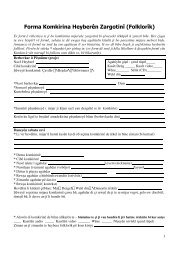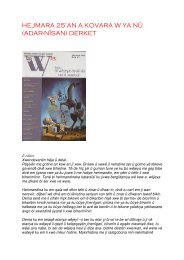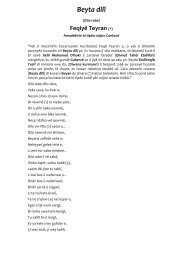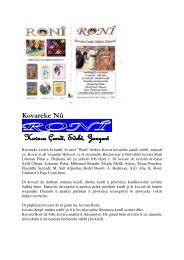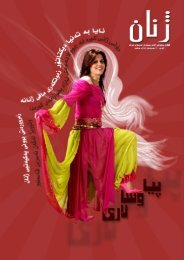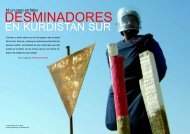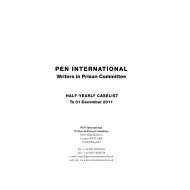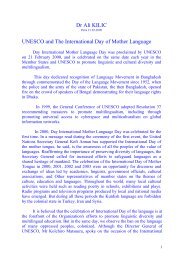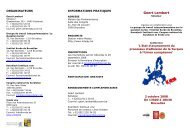The Kurds in Khorasan, North-east of Iran - Pen-Kurd
The Kurds in Khorasan, North-east of Iran - Pen-Kurd
The Kurds in Khorasan, North-east of Iran - Pen-Kurd
Create successful ePaper yourself
Turn your PDF publications into a flip-book with our unique Google optimized e-Paper software.
Of the two large detached enclaves <strong>of</strong> the <strong><strong>Kurd</strong>s</strong>, the one <strong>in</strong> <strong>Khorasan</strong> owes itsexistence to the deportations from <strong>North</strong>ern <strong>Kurd</strong>istan. Almost all the <strong>Kurd</strong>ishpopulation <strong>in</strong> <strong>Khorasan</strong> therefore speaks <strong>in</strong> Kurmanji, but centuries <strong>of</strong> exposure to theShiite community <strong>of</strong> <strong>Iran</strong> and the proximity to the Shiite holy city <strong>of</strong> Mashhad haverendered the community a mixture <strong>of</strong> Sunni and Shiite Muslims, with a pepper<strong>in</strong>g <strong>of</strong>Alewi (Alevi) adherents. It has had a far less tumultuous history <strong>in</strong> the past fewCenturies than the <strong>North</strong>ern <strong>Kurd</strong>istan most <strong>of</strong> its <strong>in</strong>habitants left beh<strong>in</strong>d. <strong>The</strong><strong>Khorasan</strong>i <strong>Kurd</strong>ish community preserves a tradition now lost to its orig<strong>in</strong>al home, astheir deportations co<strong>in</strong>cided with the beg<strong>in</strong>n<strong>in</strong>g <strong>of</strong> a susta<strong>in</strong>ed cataclysmic militaryravag<strong>in</strong>g <strong>of</strong> <strong>North</strong>ern <strong>Kurd</strong>istan by Persian and Ottoman Empires.About more than 60,000 <strong>Kurd</strong>ish families and tribes forced to move to <strong>Khorasan</strong>region / <strong>North</strong>-<strong>east</strong> <strong>of</strong> <strong>Iran</strong> (from <strong>North</strong>ern <strong>Kurd</strong>istan) dur<strong>in</strong>g Safavian Dynasty 1610AD, and the reason for that was purely political. <strong>The</strong>y were sent to <strong>Khorasan</strong> <strong>in</strong> orderto defend the prov<strong>in</strong>ce from attacks by Uzbek and Kazakhs warriors, and also toweaken the <strong><strong>Kurd</strong>s</strong> <strong>in</strong> <strong>Kurd</strong>istan which their democratic demands were not <strong>in</strong> l<strong>in</strong>e <strong>of</strong>rul<strong>in</strong>g tyrant.<strong>Kurd</strong>ish dislocation: Dr Mehrdad Izady, <strong>The</strong> <strong><strong>Kurd</strong>s</strong>; a concise handbook, 1992.<strong><strong>Kurd</strong>s</strong> who are considered to be very determ<strong>in</strong>ed and j<strong>in</strong>goistic people by nature didthe job and pushed the warriors back to where they belong to and consequently thepolitic <strong>of</strong> Shah abbas Safavi had worked to perfection by us<strong>in</strong>g <strong><strong>Kurd</strong>s</strong> <strong>in</strong> order topreserve the <strong>in</strong>tegrity <strong>of</strong> the country and his rul<strong>in</strong>g at the time. <strong>The</strong>refore, <strong>Khorasan</strong>i<strong><strong>Kurd</strong>s</strong> have rescued <strong>Iran</strong> from foreign occupation and cont<strong>in</strong>ued to do so till today.6



